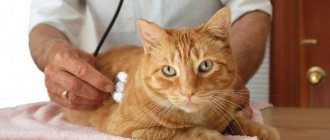The appearance of subcutaneous lumps on the body of a pet is an alarming sign that requires mandatory diagnosis. The wide variety of possible causes precludes any attempt at self-treatment. An incorrectly selected technique can harm the pet and worsen its well-being.
Despite the danger of possible consequences, do not panic. Many neoplasms are benign. For an accurate result, a thorough examination at a veterinary clinic will be required.
Types of subcutaneous formations and their symptoms
First of all, the doctor will determine the nature of the tumor. Further treatment will depend on it.
Benign
If a benign neoplasm occurs, the cat does not lose activity or appetite. The ball that appears is not accompanied by pain, is soft to the touch and is separated from healthy tissue. Such formations include:
- Syringoepithelioma
. The lump appears on the stomach, does not change size and is not accompanied by pain. The skin glands that regulate sweat secretion are responsible for its occurrence.
- Lipoma
. A simpler and more familiar name is wen. It appears at the site of fat reserves, has the shape of a circle or oval and rolls freely when palpated. The wen does not metastasize, but often increases in size. Surgical removal is allowed if there is a stable increase or persistent itching that bothers the cat.
- Hemangioma
. In 90% of cases, hemangioma is congenital. It is formed from blood vessels in the subcutaneous tissue. Swellings appear on the sides, abdomen or back of the body. If the hemangioma is acquired, then the reason for its appearance lies in ultraviolet radiation. It is typical for pets living in hot climates with free access to outdoor exercise.
- Adenoma
. The cause of adenoma development is hormonal imbalance. Nodular growths resembling cauliflower appear on the eyes, head and milk bags. In the latter case, there is a high probability of developing into a malignant form.
The danger of lipoma increases depending on where it appears. When located on the paws, it causes lameness, and when it occurs on the carotid artery, it threatens sudden suffocation due to the pressure exerted.
A purple ball on a cat’s skin, accompanied by pain when pressed, is a hematoma, that is, a bruise. Despite the presence of pain, it also refers to benign neoplasms. Sometimes a hematoma develops into a cyst, so monitoring its changes is recommended for prevention purposes.
Malignant
The first alarming symptom is an increase in temperature at the site of the lump: on the neck, head, withers or mucous membrane of the throat. If the ball enlarges and the animal experiences acute illness (diarrhea, vomiting, increased general temperature), contact your veterinarian immediately. Malignant neoplasms are dense to the touch. As they grow, the affected area becomes covered with ulcers, festers and gradually dies. Malignant tumors include:
- Swelling due to mastitis
. Small bumps appear on your pet's nipples. As they grow, the affected mammary gland increases in size, turns red and becomes hot to the touch. Gradually, foreign flakes and pus impurities enter breast milk. If the cat is nursing, she must be temporarily separated from the kittens. A sick animal becomes lethargic, loses appetite, suffers from nausea and intestinal upset.
- Mammary cancer
. If doctors suspect oncology, then in 80% of cases breast cancer is confirmed. A nodular tumor forms in the vicinity of the milk bags and the groin area. The rapid appearance of new balls in a cat on the neck and under the skin in the paw area indicates metastasis of the pathology throughout the body. The bumps turn red or purple and move freely under the skin. At an early stage, the disease is asymptomatic, preventing timely diagnosis. The occurrence of bleeding and purulent discharge indicates the last stage of cancer, which can be fatal.
- Abscess
. A painful lump filled with foul-smelling dirty-brown pus is accompanied by an increase in general temperature and local hair loss up to complete baldness of the affected area. If left untreated, the ball ruptures and infects the blood. If such a formation appears on the eye, then there is a high probability of vision loss.
In any case, there is no need to panic - it is better to throw all your efforts into saving or alleviating the fate of a sick pet. It is known that love and care can work miracles even in the most hopeless cases.
Others
In addition to the listed neoplasms, five more are distinguished. They can be both benign and malignant and can flow from one form to another. These include:
- Cyst
. Round balls with watery contents have clear boundaries. They do not hurt, they are rarely malignant, but they can bother the cat due to their large size.
- Hernia
. The size of the formations ranges from a small pea to a chicken egg. They appear near the navel or groin area and are internal organs that have prolapsed from the peritoneum under the skin. If the prolapsed organ is pinched, it lacks blood and begins to die.
- Inflammation of the paraanal glands
. The appearance of subcutaneous balls clogs the excretory tract. Inflamed glands that stimulate the process of defecation cannot perform a secretory function. The formations resemble a hernia, but are able to change their size when the pet’s position changes. If it is positioned vertically with its head up, then the balls increase in size. If his head looks vertically down, then the situation is the opposite.
- Eosinophilic granuloma
. A dense red skin formation gradually grows into neighboring tissues. An open, moist wound is formed, attracting harmful microorganisms.
- Lymphadenitis
. The cause of the disease is an inflamed lymph node. It is immobile and causes severe pain even with slight swelling. The knot has a dense structure and oblong shape.
The type of neoplasm can be determined solely by its location in only two areas: under the tail near the anus and on the stomach in the area of the milk bags. In the first case, the animal’s paraanal glands are inflamed, and in the second, we are talking about mastitis or oncology. All other cases are diagnosed exclusively by a veterinarian.
Causes and risk factors
Like people, cats age; many processes in the body begin to proceed less quickly and correctly. The likelihood of any disease, including neoplasms, increases as a result of the natural aging process.
The older the cat, the greater the risk of getting sick.
In addition, risk factors include:
- living in an area with unfavorable environmental conditions;
- hereditary predisposition;
- insufficient or poor quality nutrition;
- parasitic infestations;
- mechanical damage;
- insect bites;
- the animal has allergies;
- health problems, certain pathologies;
- immunodeficiency state.
There can be many potential reasons for the development of a pathological process, manifested by the appearance of a subcutaneous lump in an animal. It is very difficult for the owner to determine what exactly is happening to the cat. It is best to show the animal to a specialist.
Causes of subcutaneous lumps
Small round balls often appear after injection under the skin. They are called post-injection granuloma and resolve on their own a few days after the end of the injections. To avoid them, the injection site is massaged daily. Sometimes granulomas remain for life, without changing their size and position. In other cases, the reason lies in:
- blockage of the sebaceous glands;
- allergic reaction;
- infestation with parasites;
- hormonal imbalances;
- infection of open wounds;
- disturbances in the formation or functioning of connective tissues;
- injuries;
- inflammatory processes.
The risk group includes older animals, cats with chronic diseases, late castrated and sterilized pets. The risk of developing cancer increases with constant stress, low activity and poor diet. A predisposition also appears with frequent injuries in the same area of the body, infection with leukemia and regular inhalation of tobacco smoke. Cancer is often inherited and is diagnosed in animals older than 7 years.
Breast cancer in cats
One of the causes of mammary gland cancer in cats is advanced mastopathy. Most often diagnosed in older animals. In rare cases it occurs in cats, however, it has its own specifics. There are several types of cancer in cats.
Causes
As already mentioned, one of the reasons for the development of oncology in cats is advanced mastopathy. Cats develop intraepithelial cancer. The process develops due to the degeneration of epithelial or connective tissue cells. Depending on the type of cells that served as the “building material,” several types of cancer are distinguished.
Tumor stages
There are 4 stages of the disease. In the initial stages, the tumor is small. Therefore, very often the disease is not detected immediately. At stages 1 and 2, the animal eats normally, behaves actively, and does not show signs of anxiety. At the initial stage, the lump in the chest is no more than 1 cm. Closer to the second stage, its size can reach 3 cm.
The third stage is manifested by a significant increase in tumor size. It can already reach 5 cm. At the same time, the process of metastases begins. The lump changes a lot. Ulcers and wounds with bloody discharge may form on it.
The last stage is manifested by the active process of metastasis formation, as well as tumor disintegration. It can open and release contents with an unpleasant odor. In addition, the animal sharply loses weight, loses its appetite, and quickly weakens.
Clinical signs
It is not always possible to suspect the development of the disease from them:
- Slight increase in temperature;
- Bloody discharge appears;
- Ulcers and wounds may appear on the surface of the tumor;
- The animal experiences pain in the mammary glands;
- Rapid weight loss and lack of appetite are alarming signs;
- Minor lumps can be found under the skin.
Treatment methods
First of all, the cat undergoes surgery to remove the tumor. Often together with the affected organ. After this, chemotherapy is prescribed. It is worth remembering that a pet has the greatest chance of survival only at the initial stage. In a neglected state, it is doomed to death.
Prevention measures
According to experts, the only method of prevention is sterilization. After the very first heat. The animal should be examined regularly, and after 10 years of age, show it to a doctor.
Precautionary measures
If the lump under the skin turns out to be a tick, contact your veterinarian immediately. The most dangerous parasites carry encephalitis, so if treated independently, not only the cat, but also the owner may suffer. First aid is recommended only when an urgent visit to a veterinary clinic is not possible. To do this, strictly follow the instructions for removing ticks. If you don’t know her, contact your doctor by phone. Improper removal may result in blood poisoning.
Never squeeze out cones with purulent contents. Damage to such seals leads to infection of deeper layers of cellular tissue and a severe form of abscess.
In the later stages of cancer, the likelihood of saving the animal is minimized. If you want to protect your sick pet, sign up for a veterinary clinic for diagnosis immediately after detecting subcutaneous lumps.
Dangerous symptoms
Often, the appearance of a benign formation on a cat’s skin is not accompanied by any additional symptoms, and the animal does not feel any discomfort. However, you need to monitor the condition of the lump, even if it seems harmless.
You should not allow your cat to scratch the swelling, as this can lead to infection of the wound. If the tumor quickly increases in size, looks inflamed, and fluid is oozing from it, you should consult a doctor. This may indicate pathological processes that occur in the animal's body.
Symptoms that should cause concern:
- increased body temperature;
- decline in activity;
- loss of appetite and sudden weight loss;
- nausea and vomiting.
Cones can form locally in a specific location. Most often they can be found on the head, abdomen, neck, and limbs. Sometimes tumors can appear throughout the body. If there are more and more of them, you need to urgently consult a doctor.
Diagnosis and treatment of neoplasms
Diagnosis is carried out when any neoplasm appears. After a thorough examination, the doctor determines the level of danger of the resulting compaction and selects the appropriate therapy.
In addition to a clinical examination and history taking, it is necessary to check the functionality of the heart, study a general analysis of urine and blood, and also do a bacteriological analysis of the contents of the lump-vesicle. Using ultrasound and x-rays, the doctor determines the depth, exact location and size of the tumor. At an early stage, cancer is often asymptomatic, so biopsy and endoscopy are used to detect it.
The location of oncology development directly depends on the sex of the animal. Cancer in cats most often affects the testes, and in cats - milk bags. If the disease is detected at an early stage, therapy is reduced to taking special medications and gives positive results. At later stages the prognosis is negative. The patient is given painkillers and euthanized.
Table of primary and additional therapy
Drug or surgical therapy depends on the diagnosis, the state of immunity and the stage of development of the disease. Recommended treatment methods can be found in the example table.
| Type of pathology | Therapy | |
| Main | Additional | |
| Lipoma | Surgical excision of large lumps | Lipomas located near the spinal column or neck are not recommended to be touched. Intervention is allowed only if the lipoma is growing steadily |
| Hemangioma | Non-interference and surveillance | Complete surgical removal on an individual basis |
| Adenoma | Subcutaneous and intramuscular injections of antibiotics, antiviral and antifungal drugs | Surgery for increasing size |
| Mastitis | The animal is given a novocaine blockade, physiotherapy, a course of antibiotics and compresses are prescribed. | In advanced forms, surgical intervention is used |
| Cancer | In addition to special medications, the doctor prescribes radiation or chemotherapy followed by removal of the tumor | In later stages, pain management is used and euthanasia is recommended. |
| Abscess | An autopsy is performed and pus is removed using antiseptics. The treated area is isolated with a sterile bandage. Any remaining infection is treated with a course of antibiotics. | Long-term use of antibiotics is dangerous for the developing organism of kittens. If the animal is less than 1 year old, the veterinarian tries to reduce the recommended duration of antibiotic therapy as much as possible. |
| Cyst | For small formations, observation is recommended; for large ones, removal | Sometimes parasites are found in the growths. In this case, surgery is necessary even for a small cyst |
| Hernia | To remove a hernial lump, massage sessions are prescribed, the prolapsed organ is put back in place | For large formations, the doctor performs surgery to stitch the diverging ring |
| Inflammation of the paraanal glands | The accumulated fluid is squeezed out, facilitating the production of secretions | If pain occurs, the animal is injected with novocaine. If a predisposition to inflammation is identified, the cat will have to be taken for the procedure several times a year. |
| Eosinophilic granuloma | Based on the cause of the pathology, the cat is prescribed antibiotics, antihistamines or steroids. | A large weeping wound is usually excised to preserve the appearance of the affected area |
| Lymphadenitis | The disease is not independent and occurs against the background of another pathology. Painkillers, anti-inflammatory and antibacterial drugs are used for treatment | A large number of inflamed lymph nodes indicates leukemia. This pathology is not fatal, but requires long-term drug treatment |
Syringoepithelioma is not considered dangerous to health, so treatment is not provided. Hematomas resulting from minor injuries usually go away on their own or are eliminated with healing ointments.
In addition to traditional scalpel work, surgeons use laser excision, electric shock, or freezing at low temperatures with liquid nitrogen. Young and healthy animals with strong immunity often heal on their own. In this case, they receive immunity, eliminating subsequent relapses.
After surgery, the animal is prescribed a course of immunomodulators that stimulate the functioning of immune cells. The remaining wound is treated with healing ointments. Bandages can be changed yourself or at a veterinary clinic. Be sure to consult a doctor if pus continues to leak from the bandage after surgery. Some tumors found in cats are dangerous not only for animals, but also for humans.
What to do with purulent and bleeding seals?
The appearance of bleeding and purulent discharge is a symptom of cancer. Immediately upon discovering a problem, take your pet to see a veterinarian.
Before visiting a doctor, it is prohibited to treat wounds with alcohol-containing solutions, squeeze out or puncture the lump. It is also not allowed to use any ointments without prior consultation. Even plain water can make the situation worse, so do not try to rinse or wet the swelling.
If the seal breaks on its own, provide first aid to the animal. To do this, you need to treat the wound with an alcohol-free antiseptic and apply a sterile bandage. All these actions do not exclude a veterinary examination.
Detailed description of possible causes
It’s more difficult when a bump on a cat’s head appears for unknown reasons, or rather, the very moment of its appearance did not come into the owner’s field of vision. Then you have to guess and determine the cause based on the existing accompanying symptoms. If there is a possibility or need, the veterinarian will be able to figure it out faster, ruling out the following possible diseases after cytology, microscopy and histology:
- Injury. The most common cause of a soft lump on the head of a cat at any age. In the first years of life, such swellings often occur due to inexhaustible curiosity, which often ends in falling from the sofa, table or windowsill during active play. There is nothing wrong with this, all animals go through this. Such seals heal within a few days even without the use of any ointments. The situation is a little more complicated with injuries received in a fight with other animals, since swelling after a bite from teeth or a scratch from claws can become a source of infection, which will provoke an inflammatory process. Such injuries must be treated with an antiseptic solution; to be safe, you can apply a bandage soaked in levomekol to the wound for several days. At the same time, do not forget to make sure that your pet does not lick the medicine.
- Hematoma. They were specially separated from trauma, although they are closely related. If a cat has a large bump on its head after a fall from a great height or an accident, then you need to consider the option of a hematoma. They are soft to the touch and painless. The insides are filled with dried blood and lymph fluid. Small hematomas almost always resolve on their own within 1-2 weeks. After serious collisions or if the size of the mass exceeds acceptable limits (in some cases reaching the size of a large apple), a visit to the veterinarian is considered mandatory. This is necessary so that the doctor punctures the hematoma and drains the contents from it. The cavity of the resulting wound is thoroughly disinfected, and the necessary ointments with anti-inflammatory and regenerating effects are selected for the animal.
- Fleas. Bites from these insects can cause small bumps that are predominantly pink or red in color to appear on your cat's head. The bites themselves often itch, but do not hurt. The pet begins to behave restlessly, you may notice atypical behavior (itches more than usual or pays a lot of attention to a particular area of the body). The situation is even worse with animals that are allergic to flea saliva. Here you have to get rid of not only parasites, but also eliminate the symptoms of an allergic reaction. The most effective way to control fleas is considered to be regular treatment of all animals living in the same house with drugs applied to the withers. It does not matter whether the pet visits the street or not, since insects can get into its fur from the soles of the owner’s shoes or clothes. The best drugs today are considered to be Advocate, Stronghold and Frontline. Of the domestic ones, Barrier drops are praised. It is recommended to apply the drops monthly evenly to the animal’s withers so that he does not have the opportunity to lick it off. For medicinal purposes, a regimen of applying the drug three times every three weeks is used.
- Abscess. If a cat has a purulent lump on its head, there is a possibility that there is an inflammatory process caused by an infection getting under the skin. Abscesses often form after deep wounds received in a fight with other animals, when a foreign body gets under the skin. There are two options for the development of events: wait until the abscess breaks out on its own or take the pet to the veterinarian, who will open the abscess and clean it of pus. If the abscess nevertheless ruptures on its own, then it is necessary to treat the wound with an antiseptic solution and cover it with a bandage previously soaked in Levomekol ointment.
This is interesting: Instructions for use of the drug Roncoleukin for cats
What to do if your cat has a bump on his head
If you notice a lump protruding on the surface of your pet’s skin, you should first contact a veterinary hospital. If, after studying the medical history, the cause of the lump remains unclear, additional diagnostic tests are prescribed. Most often prescribed:
- general analysis of urine and blood - will help identify infectious agents and provide information about the general condition of the cat’s body as a whole;
- Ultrasound and radiography will help determine how far the process of tumor spread into muscles and tissues has progressed;
- biopsy – determines the stages of the oncological process, determines the type and nature of the tumor.
For granulomatosis, you may need to scrape off pieces of the cat's skin in the area of the lump and consult a dermatologist.
Therapy. A treatment regimen for pathological formations on the head of a mustachioed cat is developed by a veterinarian. Depending on the diagnosis, this may include:
- surgical intervention;
- antihistamines;
- antiparasitic agents;
- antibiotics and antiseptics.
Traditional medicines are usually ineffective and are used only in conjunction with official medicines.
It is important for cat owners to remember that the head is the most vulnerable place. Therefore, it is necessary to regularly examine the animal for the presence of hematomas and neoplasms, and if any are detected, you should not self-medicate, but immediately contact a veterinarian.
Prevention recommendations
Prevention alone cannot prevent cancer, but proper adherence to basic recommendations will reduce the likelihood of its occurrence. For the health of your beloved pet it is important:
- Check regularly with a veterinarian. After 7 years, the number of preventive examinations increases to twice a year. This helps to diagnose the disease at an early stage and prescribe treatment in a timely manner.
- Refuse to purchase hormonal contraceptives. Artificial suppression of sexual desire negatively affects the hormonal background of the animal. Because of this, the body malfunctions and stimulates the development of cancer cells.
- Resort to sterilization. Surgery to remove the uterus and ovaries is performed after puberty and minimizes the risk of developing cancer. General anesthesia is more difficult to tolerate at a later age.
- Treat against parasites in a timely manner and follow the vaccination schedule. When affected by helminths, ticks or viruses, secondary infections often occur.
- Monitor the quality of the diet. Any drop in immunity is fraught with deterioration in well-being.
- Follow the rules of care. Keep your skin, ears and eyes clean. Do not let your cat become hypothermic. Owners of hairless breeds are advised to purchase warm clothing for their pets.
- Avoid excessive sun exposure. Frequent exposure to direct sunlight is one of the causes of the appearance of malignant tumors.
- Monitor for swelling. Regularly push back your cat's fur and check for any questionable lumps.
- Contact your veterinarian if in any doubt. It’s better to be wrong in your assumptions than to miss the moment and lose your furry pet.
Treating cancer is hard work. Due to the constant progression of the disease, it is very important to diagnose it early. If you notice a small lump on your pet’s body that is not accompanied by dangerous symptoms, then do not lose your vigilance - veterinarians recommend undergoing an examination even if all symptoms indicate a benign neoplasm.
The article is for informational purposes only. Contact your veterinarian!











